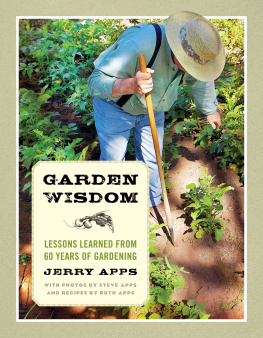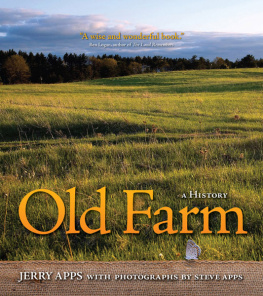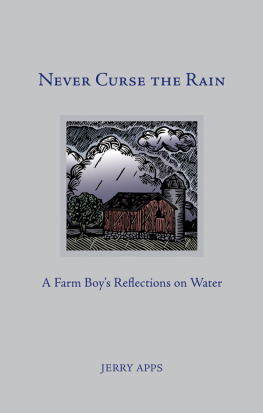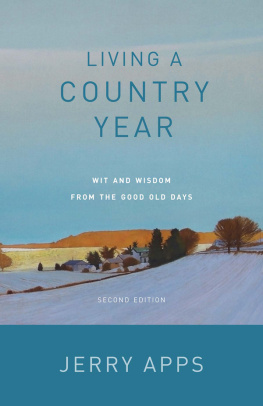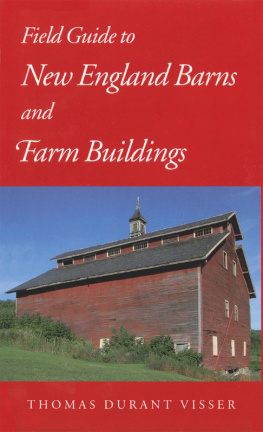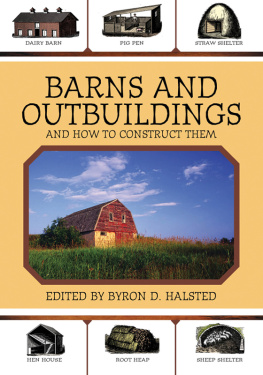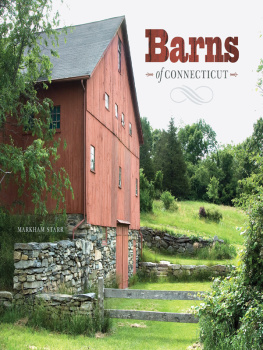Barns of Wisconsin
Places along the Way
Richly illustrated with historic and contemporary photos, the Places along the Way series links Wisconsins past with its present, exploring the states history through its architecture.
Fill er Up: The Glory Days of Wisconsin Gas Stations
Jim Draeger and Mark Speltz
photographs by Mark Fay
Encore: The Renaissance of Wisconsin Opera Houses
Brian Leahy Doyle
photographs by Mark Fay
Bottoms Up: A Toast to Wisconsins Historic Bars & Breweries
Jim Draeger and Mark Speltz
photographs by Mark Fay
Barns of Wisconsin

Jerry Apps
photographs by Steve Apps
foreword by Richard (Dick) Cates Jr.
Wisconsin Historical Society Press
Places along the Way
Published by the Wisconsin Historical Society Press
Publishers since 1855
Text 2010, 2012 by Jerold W. Apps
First edition published 1977. Second edition published 1995.
Wisconsin Historical Society Press edition 2010
E-book edition 2012
14 13 12 11 10 1 2 3 4 5
Publication of this book was made possible in part by grants from the Amy Louise Hunter fellowship fund and the D. C. Everest fellowship fund.
For permission to reuse material from Barns of Wisconsin (ISBN 978-0-87020-453-1, e-book ISBN 978-0-87020-519-4), please access www.copyright.com or contact the Copyright Clearance Center, Inc. (CCC), 222 Rosewood Drive, Danvers, MA 01923, 9787508400. CCC is a not-for-profit organization that provides licenses and registration for a variety of users.
www.wisconsinhistory.org
All photographs by Steve Apps unless otherwise credited.
Photographs identified with WHi or WHS are from the Societys collections; address requests to reproduce these photos to the Visual Materials Archivist at the Wisconsin Historical Society, 816 State Street, Madison, WI 53706.
Designed by Brad Norr Design
The Library of Congress has cataloged the printed edition as follows:
Apps, Jerold W., 1934
Barns of Wisconsin / Jerry Apps; with photographs by Steve Apps.3rd ed.
p. cm.
Includes bibliographical references and index.
ISBN 978-0-87020-453-1 (hardcover : alk. paper) 1. BarnsWisconsinHistory.
I. Apps, Steve. II. Title.
TH4930.A66 2010
728'.92209775dc22
2009049285
: Early barns took many shapes; an L-shaped barn was not uncommon. Washington County, Highways 33 and 175.
To all those people who are working to preserve their barns and farmsteads for tomorrows generation
Contents

This gambrel-roof barn has lightning rods and a metal roof ventilator. Pierce County, Highway 35 and 1150th Street, Prescott.
Foreword

Quarried block silo. Oneida County, off River Road near the fairgrounds.
J erry Appss classic Barns of Wisconsin is a gift to every citizen of the state and the agricultural Midwest. Beyond nostalgia for our rural heritage, beyond the fascinating and ingenious examples of folk architecture, the barns that Jerry has immortalized in these pages stand as a lasting testament to our unique struggles and triumphs as agrarians from distant lands who came together in this welcoming wilderness and made a life, a culture, and a society. Europe may have its cathedrals, but Wisconsins story is warmly told through its glorious barns.
These structures speak volumes about a time when most of us grew our own food, were intimate with the land we lived on, and shared our days with the animals we depended on for labor, transportation, clothing, and sustenance. Each barn instructs us about self-sufficiency, inventiveness, problem-solving, thrift, integrity, and other values we hold dear.
Perhaps the most poignant fact about these edifices is that we dont build them anymore. Our lives, our technology, our culture have moved on. People who own an old barn know they have something special, something that wont come our way again.
The cornerstone of the old barn on our family farm in Iowa County displays 1893 as its completion date on what was then the Thomas Stapleton farm. Its two-foot-thick foundation of native quarried sandstone and limestone is built into a hillside, which, as Jerry Apps teaches us, makes it a bank barn. Stapleton family lore tells us that the mason earned a dollar a day for the thirty days it took him to lay up the foundation. Zuber Hanson, a Norwegian craftsman, and his helpers constructed the 32-by-56-foot and 40-foot-high-at-the-cupola post-and-beam, wooden-pegged frame using white pine logs that had been floated down the Wisconsin River, then milled in Spring Green at the King Lumber Company: timbers, boards, and labor, $1,500. The Irish, German, and Welsh community of Jones Valley raised the barn together, just as they likely did for the barns of the contiguous neighbors, Carmody, Kraemer, Ryan, and Lloyd-Jones.
Though I farm here, we have long ceased using our old barn for the purposes it was intended for. But the vivid images of my parents and sister packing the mow elevator with small square bales of hay, my three brothers and I in the mow stacking thousands of bales a summerbare-backed, sweat-glistened, dusty boys striving to be menare a powerful part of my heritage.
Out of kindness, or perhaps in celebration of an exalted symbol, my family and I chose to renew our barn. Its restoration stretched over decades: rebuilding portions of the stone foundation, mow floor, and walls; block-and-tackles fastened to trees on the hillside, little by little pulling the structure back up straight from one hundred years against southwest winds; three layers of shingles-off, new-shingles-on; rebracing; a hundred-year barn party in 1993 (and many more parties since then).
For me, the old barns are a source of wonder and awe and are important to preserve in their own right. These barns, built by practical folks of modest means with hand tools, were not built simply to be functional; they were constructed with such care as to span generations, testament to hope and love of place. These builders valued commitment and community, and they shared an optimism that the fruits of the good earth, well tended, would serve their children, and their childrens children, and beyond. In a culture where everything else seems to change so quickly, these barns are evidence of the enduring faith of our forebears.
So, as I have also grown older, the barns have taken on another, deeper meaning for me: they are a symbolic tie that binds the next generations to all those who came before, tending the land and livestock.
For the past decade and a half I have been a teacher at the University of Wisconsin in Madison, home to a magnificent dairy barn, still in its glory, constructed in 1897. As author Apps reminds us, this is the only barn in America designated as a National Historical Monument. Fittingly, it is on this campus that I have the privilege to assist the next generation of would-be farmers get a start at fulfilling their dream to farm. In this role it is my responsibility to teach to these young people the skills they need to be successfuland just as significantly, to help them discover and cherish what is most valuable about the culture of agriculture for which they are to become the torchbearers.


